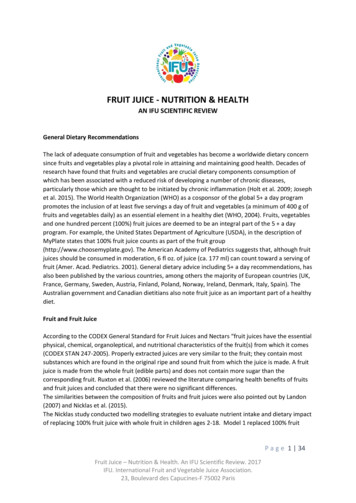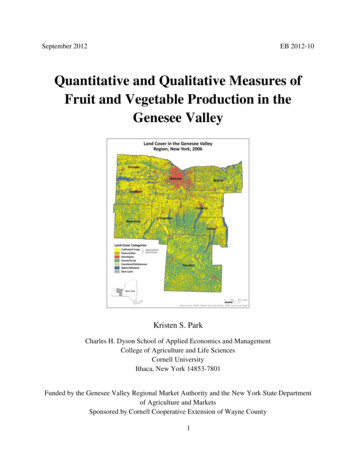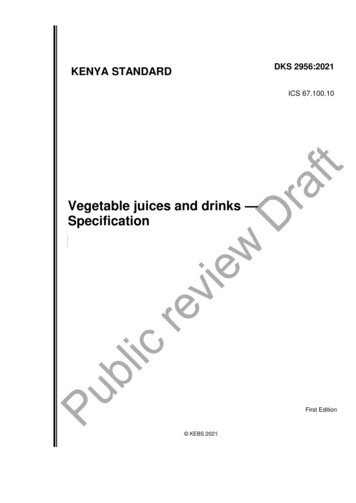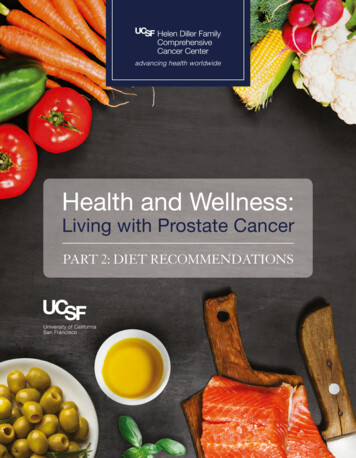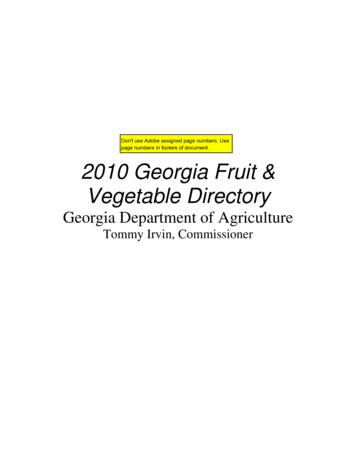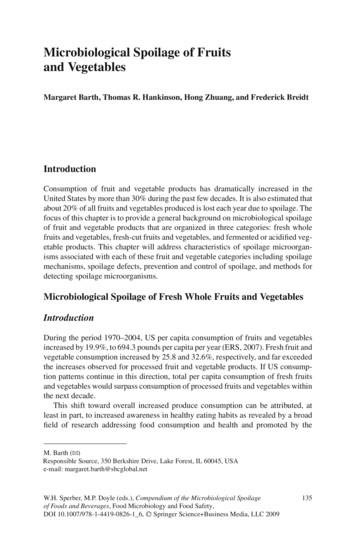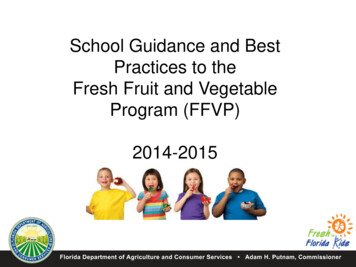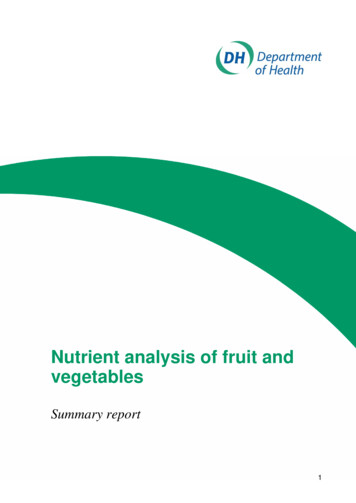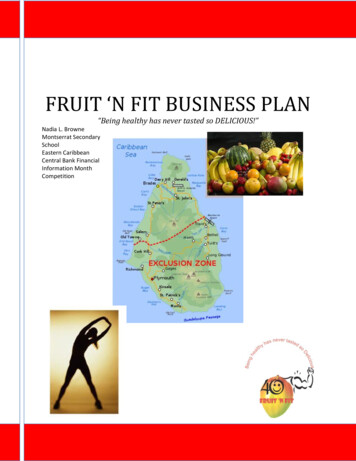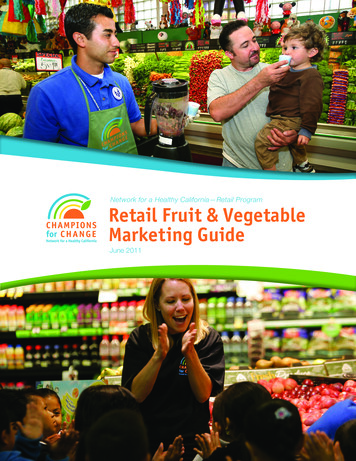
Transcription
Network for a Healthy California—Retail ProgramRetail Fruit & VegetableMarketing GuideJune 2011
Network for a Healthy California—Retail ProgramEating the right amount of fruits and vegetables as part of a lowfat, high-fiber diet may lower the risk ofserious health problems like obesity, type 2 diabetes, heart disease, stroke, and certain types of cancer. Forthis reason, the Network for a Healthy California—Retail Program (Retail Program) forms partnerships withCalifornia fruit and vegetable growers, packers, shippers, wholesale distributors, retailers, and commodityboards to create more opportunities for low-income California families to eat the recommended amount ofcolorful fruits and vegetables every day.The Network for a Healthy California (Network) is a statewide social marketing campaign administeredby the California Department of Public Health (CDPH) in cooperation with the California Department ofSocial Services. It is funded primarily through the United States Department of Agriculture (USDA) toprovide a variety of nutrition education services (such as those offered by the Retail Program) through theSupplemental Nutrition Assistance Program (SNAP), known in California as CalFresh.After the Network adopted the Champions for Change brand in 2007, the Retail Program updated theirretailer materials and services and found that owners of small and medium size, independently-ownedmarkets and corner stores were interested in participating in the Retail Program even though they did not sellfresh fruits and vegetables.The addition of fruits and vegetables to the Special Supplemental Nutrition Program for Women, Infants,and Children (WIC) food package in 2009 caused even more small retailers in our service areas to ask forresources that could help them improve their fresh produce offerings.In response to these requests, we were able to compile the Retailer Fruit and Vegetable Marketing Guide(Guide) which we hope is a good introduction to handling, storage, and produce marketing in the small- ormedium-size store environment. Because this Guide is not meant to be all-inclusive, we also list a number ofresources that may help motivated retailers like you learn even more about the fresh produce business.Retail Program Regional Specialists can provide you with additional information, materials, and may even beable to refer you to community-based organizations that promote healthy retailing in your area.We hope that you will find this Guide informative and helpful. Many thanks to the people, publications, andorganizations whose experience and expertise (see page 54) made this Guide a reality.N E T W O R K F O R A H E A LT H Y C A L I F O R N I A — R E TA I L P R O G R A M
Table of ContentsHealthy Changes Can Pay Off . . . . . . . . .1Meeting Your Customers’ Needs . . . . . . .2Ask Around . . . . . . . . . . . . . . . . . . 2In-Store Customer Surveys . . . . . . . . . . 2Produce AislePromotional Activities . . . . . . . . . . . . . 25Product Sampling . . . . . . . . . . . . . . 25Other Community Activities . . . . . . . . . 26Working with Youth Groups . . . . . . . . . . 2Staff Training Tools . . . . . . . . . . . . . . . 28Making a Plan for Success . . . . . . . . . . . 3Keep It Going . . . . . . . . . . . . . . . . . . 29Making a Budget . . . . . . . . . . . . . . . 3Operations Guidelines . . . . . . . . . . . . 29Customer Support . . . . . . . . . . . . . . 4Revenue from Federal NutritionAssistance Programs . . . . . . . . . . . . 30Store Layout . . . . . . . . . . . . . . . . . 4Store Appearance . . . . . . . . . . . . . . 5Selecting Produce Items . . . . . . . . . . . .6Acknowledgements . . . . . . . . . . . . . . 54AppendicesProduce Storage Guidelines . . . . . . . . . 6Glossary . . . . . . . . . . . . . . . . . . . AReceiving and Stocking Tipsby Armand Lobato . . . . . . . . . . . . . . 8In-Store Shopper Survey . . . . . . . . . . . BProduce Display Considerations . . . . . . . 10Produce Handling Grids . . . . . . . . . . . DStorage and Display Equipment . . . . . . . 13Produce Receiving Tips . . . . . . . . . . . EDisplay Tips by Armand Lobato . . . . . . . 15Storage Mapping . . . . . . . . . . . . . . . FSelecting a Produce Distributor . . . . . . . 20Produce Quick Tips . . . . . . . . . . . . . . GProduce Aisle Merchandising . . . . . . . . . 22Retail Program Merchandising Materials . . . HLocation and Packaging . . . . . . . . . . . 22Resources . . . . . . . . . . . . . . . . . . KCommunity Survey . . . . . . . . . . . . . . CSignage and Educational Materials . . . . . . 23This material was produced by the California Department of Public Health’s Network for a Healthy Californiawith funding from USDA SNAP, known in California as CalFresh (formerly Food Stamps). These institutionsare equal opportunity providers and employers. CalFresh provides assistance to low-income households andcan help buy nutritious foods for better health. For CalFresh information, call 1-877-847-3663. For importantnutrition information, visit www.cachampionsforchange.net.TA B L E O F C O N T E N T S
Healthy Changes Can Pay Off!Thank you for choosing to promote fruits andvegetables in your store. Educating your customersabout the healthy food items that you choose tomake available is not only a great service to thecommunity, but the best way to increase your freshproduce sales. This Guide is full of helpful ideas,tips, and resources that will help make your freshproduce marketing plan more successful.Choosing to sell fresh fruits and vegetables andcreating marketing plans for new produce canbe time consuming. But dedicated store ownerslike you have seen great results, whether it is inimproved produce sales, an increase in customerloyalty, or welcoming new shoppers to their store.Before you get started, consider finding communityorganizations that are dedicated to improving thepublic’s health by creating healthy communities.They may be able to help you make and promotechanges that will help you improve your selection offresh produce. The Network works with a variety ofschools, local health departments, community youthorganizations, churches, community centers, clinics,worksites, and other organizations to promote fruitsand vegetables.H E A LT H Y C H A N G E S C A N PAY O F F !To find out more about community organizationsin your neighborhood that are already working withthe Network, contact your local Retail ProgramSpecialist.1
Meeting Your Customers’ NeedsIf you have never sold produce before, it mightbe a good idea to start small with snacking andimpulse buy items like apples, oranges, bananas,baby carrots, or even seasonal items packaged into“snack bags.”When the time comes to expand, try to find outwhat types of produce your customers prefer. A2007 survey of women that participate in the WICProgram found that bananas, tomatoes, apples,oranges, grapes, onions, strawberries, avocados,asparagus, carrots, and lettuce were the preferreditems among those shoppers. You’ll also want toselect the items that you are best equipped to carryand store so that they stay fresh and attractive toyour customers (see Selecting Produce Items,page 6).ASK AROUNDAs you talk to your customers day in and day out,what types of produce items have they asked for?Ask if there are any seasonal favorites that they’dlike you to carry. Find out if there are any produceitems that they would use as day-to-day snacks fortheir families. As an independent retailer, you have apersonal relationship with your customers that canhelp you make good decisions about what type ofproduce to start carrying and how to promote thenew items to maximize sales.IN-STORE CUSTOMER SURVEYSSurveying your customers is another way to improveyour chances of successfully carrying and sellingmore fruits and vegetables. This Guide has anexample of a survey (see Appendix B) that you canuse to help choose fruits and vegetables that yourcustomers will buy. Providing short surveys for yourcurrent shoppers is easy to do, in-store, and can tellyou a lot about what they like.Alternatively, you can work with communityorganizations to conduct a sidewalk ordoor–to-door survey to find out what the entirecommunity thinks about fruits and vegetables.MEETING YOUR CUSTOMERS’ NEEDSPhoto by Tim Wagner for HEACWORKING WITH YOUTH GROUPSYou can recruit local youth to help talk withcustomers or conduct surveys. Communityorganizations that have after-school programs or anon-profit that works with young people can helpyou find volunteer youth to help conduct surveys.Three to seven volunteers can talk to enoughcustomers to help you make a sound decisionabout what types of changes you should maketo promote fruits and vegetables in your store.Talking to or surveying 50–100 of your customersor community members that live near your storewill give you a good idea of what types of changesyou might consider. It is ideal to conduct thesurveys at different times of the day or even “semirandomly” (for example, interviewing every third orfifth customer) to ensure you collect responses froma broad sample of your customers. This takes moretime and effort, but you may get more responses aswell as an additional opportunity to alert communitymembers of the changes you plan to make. If theyouth go door-to-door, have them work in groups oftwo or three. If they survey people on the sidewalk,have them split up to prevent holding up foot traffic.2
Making a Plan for SuccessTo ensure a successful and sustainable fruit andvegetable marketing plan, you will need to revisityour current business plan. Whatever you do topromote fruits and vegetables in your store mustmake good business sense. What are your reasons for wanting to sell morefruits and vegetables? What are your store’s strengths and weaknesses?Which items pull in the most profits? What are your future fruit and vegetable salesgoals? How can increased fruit and vegetable sales payfor any storage or display equipment that you’dlike to buy? Can you get assistance from local business,redevelopment, or public health organizations?Your Financial Investment How much can you invest in produce items? Howmany different items can you afford to store anddisplay? Will you need any additional storage or displayequipment (see Storage and Display Equipment,page 13)? If so, how much can you afford to invest andwhat kind of produce sales will you need to coverthe cost of the equipment? The average amountspent on getting the supplies needed to store anddisplay fresh produce can range from 3,000 5,000. Consider any extra electricity costs for newequipment. Can you buy produce directly from local farmers? How much would you have to markup produceitems to pay for any new equipment? Are there produce distributors who can offer yougood prices and assistance with storage, display,and merchandising plans? What is a reasonable markup (enough to pay forany new equipment and sustain the inventorywhile remaining affordable for your customers)?Once you have a good idea of your overall goals,strengths, weaknesses, local resources, andopportunities, you can ask yourself some detailedquestions that will help you make a successfulproduce marketing plan. What are your labor costs? For example, if youhave a 7% markup on bananas, how much doesit cost you to have them delivered or picked-up,stored, and displayed?MAKING A BUDGETYour main goal is to maintain or to increase yourcurrent profits so that you can continue to offer thiswonderful service for the community. Increasingyour produce sales may create a loss in profits atfirst, but with the right plan, you will likely recoveryour profits and maintain your produce sales withtime. Create a budget for your produce marketingplan that allows you to stay on track with yourfinancial goals.MAKING A PLAN FOR SUCCESSYou are not alone. Private, community, city, andstate agencies may be able to provide resources(funds, equipment, staff assistance, etc.) to supportyour plan to sell more fruits and vegetables inyour store. Agencies like your local chamber ofcommerce or city redevelopment agency maybe able to help you evaluate your business planand provide business counseling to build a strongbusiness model. This will give a solid foundation tosell more fruits and vegetables.3
Your Customer Service OptionsCUSTOMER SUPPORTShould you sell items by piece, package, or weight?Review the surveys completed by your customersto find out which produce items will sell the best,as well as what type of promotions are likely to helpthem learn how to purchase and prepare fruits andvegetables (see Meeting Your Customers’ Needs,page 2). Consider the minimum amount ofmarkup necessary to sustain your fruit andvegetable sales and which promotions aremost appropriate and affordable for your store.Communicate your decision to sell fresh produce toyour shoppers. This will establish a sense of trust,showing that you value their opinion and that theyhave a voice in what produce is sold at your store. Selling by the piece is easy for both you and yourcustomers because you won’t have to invest inscales. Customers will know exactly what they aregetting and for how much (three bananas for adollar, apples for 0.30 each, etc.), which will leadto a speedy check-out.STORE LAYOUTLook around your store. Where can you stockvarieties of fresh produce so that they can easily beseen by customers? The answer to this questionwill help you determine how much produce you canstock and what type of promotions you can holdwithin your store.Photo by Tim Wagner for HEAC Selling by the package is also convenient, butrequires additional work by either your staff oryour distributor. Packaged produce also hasspecial handling considerations (see ProduceStorage Guidelines, page 6). Selling by weight is common in larger stores, butif you don’t have room for scales, or the time tomake sure they are correctly calibrated, selling bythe piece or package may be the way to go.Do you, or should you, accept EBT CalFreshbenefits (formerly known as Food Stamps andcurrently known federally as Supplemental NutritionAssistance Program [SNAP] benefits) or WICvouchers as a way to help customers pay for freshfruits and vegetables (see Keep it Going!, page 29)?MAKING A PLAN FOR SUCCESS After reviewing your business plan, can youidentify items that can be moved, decreased, oreliminated to make room for the fresh produceitems you would like to carry? Check if you have any vendor contracts thatrequire you to keep certain items in the front ofyour store before you move anything (e.g., if anice cream company gave you a free freezer withtheir name on it under the condition that you placeit within 20 feet of your front door). If you chooseto change your floor plan, try to leave enoughroom for customers to shop, and be careful tokeep household and food items separate (e.g., doNOT place bleach near a basket of apples). Are you using your sales space for all it’s worth?Try to avoid using your valuable floor space tostore items that could be kept in your backroom.4
STORE APPEARANCEThe way your store looks can affect how muchproduce you sell. If your sales floor is cluttered,customers may assume your produce is not fresh.If your store displays a lot of alcohol and tobaccoadvertisements, people may not realize you sellfresh produce. Are there any visual improvementsthat you will need to make to help your freshproduce selection seem more attractive (replacingunnecessary, cluttered, or damaged signs withattractive signage, clear pricing on shelf talkers,proper lighting, etc.)?Photo by Tim Wagner for HEACOnce you have completed your customer surveysand evaluated your business plan, you are preparedto decide if a produce marketing plan is right foryou, your business, and the community that youserve.MAKING A PLAN FOR SUCCESS5
Selecting Produce ItemsCompare the produce items your customers reported that they would like to buy with what is in season,what will sell quickly, what you are able to store and display, and what you can find at a reasonable price froma local farmer or distributor (see Selecting a Produce Distributor, page 20). It’s a good idea to start off sellinga small amount of produce to test what will sell well. That way you will not have to find space for scales andmaintain their accuracy.PRODUCE STORAGE GUIDELINESStorage TemperatureDifferent produce items require different storage temperatures to maintain good quality, which will improvesales. Keep the following storage chart in mind when selecting produce items.Optimal Storage Temperatures for up to Seven Days of StorageGroup A: 32-35 FGroup B: 45-50 FGroup C: 55-64 FOr an air conditioned roomFruitApplesAvocados s AsparagusBroccoliBok ChoyCabbageCarrotsCauliflowerCeleryCollard GreensCornKaleLettuceMushroomsParsnipsSpinachSwiss ChardVegetablesBell PeppersCactus Leaves (Nopales)ChayotesChili PeppersEggplantsGreen BeansOkraZucchinisYellow SquashVegetablesAcorn SquashButternut SquashJicama*Onions*Potatoes*Sweet Potatoes*Tomatoes** Do not refrigerate this item! Cold temperatures may damage flavor and texture.SELECTING PRODUCE ITEMS6
If you only have one refrigerator, you can storeGroup A and Group B items together in a 40 Frefrigerator (which is cool enough to store dairy,eggs, or meat if you sell these items as well).Because this temperature is a little warm for GroupA items and a little cool for Group B items, theywill not last as long, so you might want to havemore than one produce pick-up or delivery a week.Group C items can be stored in a well ventilated, airconditioned room.EthyleneEthylene is a natural gas made by some fruits andvegetables. Ethylene causes certain fruits andvegetables to ripen faster, which can lead toover-ripening and spoilage. For this reason, youwant to be careful that ethylene-producing itemsare kept away from ethylene-sensitive items andthat your storage and display areas have goodventilation. Spoiled produce makes even moreethylene (one bad apple spoils a bunch)!Produce items that make ethylene asPeachesPearsPlumsTomatoesProduce items that make ethylene should not bestored or displayed next to items that are sensitiveto ethylene. Produce items that are sensitive toethylene tesCollard GreensGrapefruitGreen SELECTING PRODUCE low SquashMost ethylene-producers are sensitive to ethyleneas well. These items should be stored in wellventilated boxes or containers so that the ethylenethat they create can escape without causing themto spoil.Odor-Absorbing ProduceSome produce items can absorb bad odors orflavors from other produce items. Please see theProduce Receiving Tips (Appendix E) to determinewhich items should be stored away from oneanother.IcingSome produce items can tolerate being icedand may be delivered packed in crushed ice. Itis important to know if your produce distributordelivers any of the following items packed in icewhen you are making your storage plans so that youcan be sure you have adequate drainage for meltingice. Produce items that can tolerate (but do notrequire) icing uliflowerCeleryCollard GreensCornKaleParsnipsSpinachWatermelonPrepackaged ProducePackaged fruits and vegetables offer a convenienceto the consumer, but they require special handling,storage, and display considerations. Damage toone apple within a three pound bag due to improperhandling, storage, or display can affect the others,resulting in faster spoilage of the whole bag ofapples. It is important to scan bags or packages asthey are delivered or before pick-up and reject thosethat have rotten pieces. As they are stored anddisplayed, continue to check for spoiled pieces andthrow away bags or packages with rotting produceas necessary.7
RECEIVING AND STOCKING TIPS(Adapted from an article written by Armand Lobatoof Produce Merchandising Magazine)Follow this general, nine-step process to properlyprepare for, receive, and handle an incomingproduce delivery.1. Prepare the backroom. Get rid of trash, stackempty boxes, and condense merchandise tomake room for the load.2. A place for everything, and everything in itsplace. You can create maps of your refrigeratorspace to find out where the coldest (usuallynear the fan) and warmest (usually near thedoor) spots are located to help you store yourproduce at the right temperature for the bestflavor and the least spoilage. Keep items in thesame place each day so you can quickly findneeded product. When unloading the truck, tryto park items in set areas to minimize handlingthem multiple times.3. Know your temperature zones. When pickingup or receiving a produce delivery, accept onlyproduce items that are within their recommendedtemperature ranges (see Storage Temperatureon page 6). Otherwise, they may not last as longin storage or on display.Maintain the “cold chain.” Cold stuff stays cold.Warm items, such as bananas, get stackedoutside of the cooler. Packaged salads losea day’s shelf life for every hour kept out ofrefrigeration. Bananas and pineapples sustainchill damage easily, and stone fruit (peaches,plums, and nectarines) has “kill zones” if kepttoo cold or too warm. Basic knowledge aboutstorage will help minimize waste and maximizeprofits.4. Handle with care! Never throw or drop produce.This can cause damage and shrink (i.e., lossof inventory). Be careful not to subject fragileitems, such as berries or mushrooms, tocrushing. Dropping a box of apples as little asSELECTING PRODUCE ITEMSthree inches can drastically decrease their shelflife and increase waste. Inspect items as youput them away for signs of damage. If you seea produce item that you would not buy, neitherwill your customers!5. Rotate items using the First-In-First-Out (FIFO)method. Place newer items below or behindolder items so that you can be sure to rotateall of your produce inventory out onto the salesfloor before it goes bad. When stacking cases,make sure the printing on the outside of boxesis visible so you know what is being stackedwhere. This will make selection a breeze andsave valuable time.6. Dating keeps track of aged inventory. Cartonshave a way of overstaying their welcome, so bymarking cases with a received-on date (eitherwith a marking pen or price gun) you can see ata glance which items must be moved first.7. A clean ship is a happy (and safe) ship. Stackaway empty pallets, dump the trash, sweep,and mop the floor.8. Check the load you just put away. Dideverything arrive as ordered, compared to yourinvoice? This is the time to note outages orshorts and make adjustments with your supplieror warehouse.9. When a load is put away, step into the coolerand dry storage area and ask these questions: Is everything accessible? Can I quickly tellwhich apple varieties are which? Which shelfholds chilies? Which shelf has cabbage? Are the items in the cooler rotated and dated? Are sensitive items protected (i.e. nothingheavy crushing boxes of grapes, mushroomsaren’t being dried out by the fan, are thebanana lids off to slow ripening)? Finally, is the storage area safe? Free fromexcess water or debris, and well lit?8
Mapping Your StorageThere is a lot to remember when it comes to storing fresh produce. One way to keep track of it all is to makea storage map for your refrigeration and dry storage areas.The diagram below is an example of how a store owner might map out his or her storage space to preparefor new produce items (see Appendix F for more information on how to do nsLemons8/208/20SpinachSpinachCoolingFanFanCooling at roccoliBroccoli8/208/20WatermelonWatermelonKeep heavy itemsfrom crushingfragile items.Keep items at least sixinches off the groundand away from walls.SELECTING PRODUCE taloupeMake older items easierto take out by stackingthem on top (first in, firstout).8/158/15EggsEggsCover itemsthat can dry outeasily with aclean blanket orsack.Keep items that needto be cooked belowor separate fromready-to-eat items.Keep items packed inice from dripping onother items.9
PRODUCE DISPLAY CONSIDERATIONSTemperature and TurnoverProduce lasts longer if it is displayed at atemperature that is close to its storage temperature.Be sure not to display produce items on theground. Not only is it unappealing, but the groundtemperature can heat up the produce items andcause them to spoil faster. Most refrigerated, openair display cases are not powerful enough to cooldown warm produce items, so make sure theproduce items are already cold before placing themin the case.Some items have a short shelf life and should notbe in your store longer than three days. Other itemsshould be sold before seven days. Remember thatproduce loses flavor before it looks bad. Sellinggood tasting produce brings customers back formore. The goal is to sell fresh produce as soon aspossible and to restock regularly.Produce items that should be kept inrefrigerated display cabinets:ArtichokesAsparagusBroccoliBok ChoyCabbageCauliflowerCeleryCherriesCollard GreensCornGrapesGreen BeansLettuceMushroomsSpinachStrawberriesSwiss ChardIf you do not have refrigerated storage or display,you should not attempt to sell these items.Displaying produce in a bed of ice withoutrefrigeration is not an effective way to keep themcold.SELECTING PRODUCE ITEMSProduce items that should be kept on displaytables or racks at room temperature andprotected from direct sun light and drafts:ApplesAvocadosBananasBell esPearsPineapplesPlumsPotatoesSweet PotatoesTomatoesWatermelonsOnce items like kiwifruit, nectarines, peaches,pears, and plums fully ripen, they can be kept in therefrigerated displays with “Ready to Eat” signage.10
Misting (optional)Considerations About Leafy ProduceSome produce items go bad because they dryout too quickly. These items would benefit fromregular misting while on display. Misting can helpdouble the shelf life of certain produce items andgive produce a fresh, crisp look. Be careful not tosoak these items with water. Misting these items for6-8 seconds every 6-8 minutes is recommended ifyou have access to a refrigerated display case withan automatic misting system. Produce items thatbenefit from regular misting are:If you choose to carry leafy produce, be sure thatyou have room for trimming, soaking, and crispingthese items (lettuces, kale, collard greens, cabbage,etc.). This does not have to take a lot of space, butit is a vital process that will revive wilted leafy greenproduce items and almost triple their shelf leryCollard GreensKaleLettuceParsnipsSpinachSwiss ChardIf you do not have access to refrigerated mistingequipment, these items will benefit from being soldin clamshell containers or plastic bags, which canhelp prevent them from drying out. Other items canbe damaged by misting, so if you are not carryingand selling enough of the items listed above tojustify purchasing misting equipment, then makingthat kind of investment is not recommended.SELECTING PRODUCE ITEMS1. Cut a thin slice off the bottom of the stalk orcore, making sure not to cut so deep that itemslike cabbage or heads of lettuce fall apart.Remove any damaged or discolored outerleaves.2. Soak the items in lukewarm water for about15-20 minutes.3. Drain and place back in the refrigerator to coolbefore displaying.You can prep an entire box of leafy greens usinga trash can for the trimmings and bucket of clean,drinkable water for soaking. You’ll be amazedat how much these three steps can refresh yourinventory of leafy greens.11
Organic ProduceRotationThe optimal storage conditions are the samefor both organic and conventional (non-organic)produce. The storage life for organic produce maybe shorter than conventional produce if conventionalitems are treated to limit decay or waxed to reducewater loss. The main concern in handling of organicproduce is to keep it separate from conventionalproduce so that there is no possibility of mislabelingthe organic produce. It is best to use separatedisplay areas for the organic produce.Check your produce items a few times a day asyou are going about your other duties in the store.Throw away any bruised, damaged, foul smelling, orshriveled items (this process is also called culling).It is hard to throw away inventory, but if you don’t,your customers may not buy anything because theirattention will be drawn to the damaged producein your display and not the good quality items.Be sure to restock whenever the display starts tolook empty. Empty displays look picked over andunappealing. Remember to stack older producein front or on top of the newer items so that it sellsfirst (FIFO). To preserve inventory, avoid bruising byhandling gently, controlling temperature, mistingwhere appropriate, and stacking carefully.StackingWhen putting produce on display, make sure that itis not stacked so thickly that air can not circulate. Ifstacking produce in a refrigerated display case, donot stack items so high that the top lay
produce marketing plan more successful. Choosing to sell fresh fruits and vegetables and creating marketing plans for new produce can be time consuming. But dedicated store owners like you have seen great results, whether it is in improved produce sales, an increase in customer loyalty, or welcoming new shoppers to their store.
